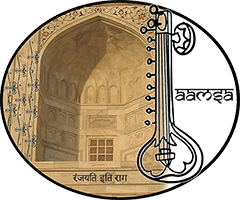Krishnaswamy/Wells
Analytical Approaches to Music of South Asia, Volume 1 (2023)
A Novel Generative Paradigm for Carnatic Rhythmic Composition
Jagdish A. Krishnaswamya and Robert Wellsb
Author information: aIndependent scholar (email: jagdish.ak@gmail.com); bUniversity of Mary Washington (email: rwells@umw.edu)
Received May 12, 2022; Accepted pending revisions March 29, 2023; Revised version received May 30, 2023; Published December 26, 2023.
Abstract: Mathematical structures are deeply embedded in the aesthetics of South Indian Carnatic music. Kōrvais, whichare rhythmic compositions performed in triplets in various parts of a concert, are the culmination of this mathematical aesthetic. Each kōrvai has two parts, the first called the pūrvārdha and the second called the uttarārdha, both based on mathematical structures that are aesthetically acceptable according to certain constraints. These structures have evolved traditionally and can accommodate most rhythmic requirements. However, the traditional methods are inadequate in addressing certain specialized constraints. Therefore, this article revisits rhythmic composition through conceptualization of newer rhythmic patterns and use of algorithmic approaches to determine the components of the kōrvai. Specifically, we systematically address the need for newer rhythmic compositional paradigms in Carnatic music by first introducing the fundamentals of Carnatic rhythmic compositional theory and practice via a collection of mathematical models. We subsequently highlight the limitations of traditional methods and outline the requirements of newer approaches, which will be exemplified through four new kōrvais. We further exemplify, via video-recorded performances, how the proposed approach can be easily extended beyond percussion solos to Carnatic vocal presentations. The final section considers how these algorithmic approaches to Carnatic rhythmic composition could also be useful in other, non-Carnatic systems of music, with newly composed examples for illustration.
Keywords: Carnatic music; rhythmic composition; tāḷa; kōrvai; algorithm; eḍuppu; arithmetic progression; rhythmic offset
© 2023 by the authors. Users may read, download, copy, distribute, print, search, or link to the full texts of this article without requesting permission. When distributing, (1) the author of the article and the name, volume, issue, and year of the journal must be identified clearly; (2) no portion of the article, including audio, video, or other accompanying media, may be used for commercial purposes; and (3) no portion of the article or any of its accompanying media may be modified, transformed, built upon, sampled, remixed, or separated from the rest of the article.
To view an image (figure, example, or table) at its original size, right-click (or control-click) on it, and select “Open image in new tab.” To download an image or a video, select “Save image as” or “Save link as” instead. (The latter can be helpful when accessing a longer video, which might load slowly.)
Click here to read the PDF version of the article
Introduction
[1] In South Indian “Carnatic” (classical) music, traditional constraints on rhythmic designs can inspire musical creativity, but can also produce compositional or improvisational limitations. Despite the wide range of available mathematical tools, the most common approaches to overcoming these limitations have been either through new rhythmic patterns derived using trial and error, or through relaxation of certain constraints. Thus, in this article, we develop a collection of novel, mathematically generated rhythmic designs that can provide fresh creative possibilities for Carnatic musicians, while also being of interest to music theorists and composers more broadly.
[2] To achieve these goals, the first section of this article (Introduction) outlines our project’s primary goals and methods. The second section (Theoretical Concepts) then provides an overview and mathematical formalization of beat cycles (tāḷas) and rhythmic subdivisions, yielding quantitative tools useful not only for the current study, but for future Carnatic rhythm research. We also introduce the musical context and basic structure of South Indian classical percussive music. After these preliminaries, we argue for the need for a more advanced, algorithmically based approach to rhythmic composition by highlighting “mathematically difficult” rhythmic structural requirements that traditional methods are inadequate to address. Finally, we discuss the aesthetic requirements of any novel proposed approach.
[3] In the third section (A Deterministic Approach to Rhythmic Compositions), we formally introduce the new algorithmic approach to rhythmic composition using the special case of rūpaka tāḷa, a 3-beat rhythmic cycle with 4 subdivisions per beat. After indicating musical constraints in this tāḷa that render traditional, trial-and-error-based approaches inadequate, we show that our deterministic, linear-algebraic approach can provide a potentially infinite number of elegant solutions that simultaneously satisfy all aesthetic and rhythmic requirements.
[4] While section three represents a fundamental shift in the way rhythmic compositions are handled by Carnatic percussionists, vocalists, and non-percussive instrumentalists, section four (Compositional Applications Beyond Carnatic Music) considers possible applications to musics outside the Carnatic tradition. Specifically, we discuss the notion of imposing musical constraints as an artistic choice, which allows the current study to be applied to Western classical composition, jazz, and other styles. The section will conclude with two newly written compositional illustrations.
Theoretical Concepts
Rhythmic Cycles, Divisions, and Subdivisions: Mathematical Representations for Tāḷa, Āvartana, Naḍai, and Eḍuppu
Mathematical Preliminaries: Rhythmic Cycles and Rhythmic Divisions
[5] Time is continuous, but most musical compositions articulate time in rhythmic patterns that repeat periodically. A pictorial representation of how time is hierarchically broken into periodic chunks in Carnatic music is shown in Figure 1.
[6] At the highest level, we refer to each periodically repeating chunk as a rhythmic cycle or an āvartana. Within each āvartana are a finite number of equally-spaced divisions called akṣaras or “beats,” and within each beat are a finite number of subdivisions. The number of beats and their grouping within a cycle define what is known as a tāḷa (Nelson 2017). Specifically, the tāḷa in Carnatic music is a particular configuration of beat groupings, called angas, that are mostly (with exceptions) demarcated by kriyās (characteristic hand gestures). Note that the example of tiṣra tripuṭa tāḷa in Figure 1 consists of seven-beat cycles divided into angas of lengths 3, 2, and 2, respectively, and each beat is marked by a specific kriyā.

Figure 1: The internal structure of the Carnatic tiṣra tripuṭa tāḷa, which consists of seven-beat cycles divided into angas of lengths 3, 2, and 2, respectively.

Figure 2: The three-level hierarchical structure of a rhythmic cycle (āvartana) of a tāḷa.
[7] We now present a broader, more mathematically based representation of Carnatic tāḷa; the reader uninterested in these mathematical details may skip to the next subsection (paragraph [16]). Figure 2 provides a generalized depiction of tāḷa structure and hierarchy.
[8] Here we denote an āvartana by Ap, where the index p refers to the position of the āvartana in time (A1 is the first āvartana and Ap is the pth āvartana). Within a given tāḷa, a single āvartana has duration Tcycle (measured in seconds) and consists of a finite number n(a) of angas, which are the largest divisions of a tāḷa. If each anga a1 has duration T(a1), then we have the equation given in Figure 3.

Figure 3: Duration-based representation of an āvartana as the sum of its component angas.
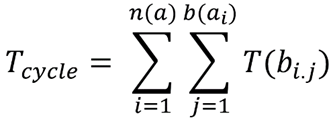
Figure 4: Duration-based representation of an āvartana as the sum of beats across all angas.
[9] The ith anga of the tāḷa has b(a1) beats/divisions. Each beat is physically displayed through a distinct hand movement (patting using the palm, the back of the hand, or the fingers) as the tāḷa proceeds. The jth beat of the ith anga (denoted by bi.j) has duration T(bi.j) , yielding the equation in Figure 4.
[10] Finally, each beat consists of basic time units we will call “subdivisions.” The jth beat of the ith anga, bi.j, has s(bi.j) subdivisions. The kth subdivision of the jth beat of the ith anga, denoted by si.j.k, has duration T(si.j.k). The subdivisions of a beat are not represented by distinct hand movements. They simply fill time between beats and can be said to constitute laya. Therefore, the time interval Tcycle of one rhythmic cycle of the tāḷa can be expressed as shown in Figure 5.
[11] The formula in Figure 5 shows a generic 3-level hierarchical breakdown of an āvartana sequentially into angas, beats, and subdivisions. Typically, the subdivisions are basic time units of equal duration, forming the most granular level of rhythmic structure.[1] Hence, T(si.j.k) = t0 for all i, j, k, where t0 is a constant, allowing simplification of the expression in Figure 5 to that in Figure 6.[2]

Figure 5: Duration-based representation of an āvartana as a sum of subdivisions across all beats within all angas.
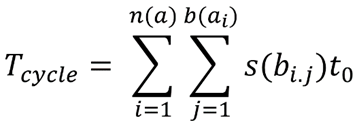
Figure 6: Simplified representation for the duration of an āvartana when subdivisions have constant length t0.

Figure 7: Simplified representation for the duration of an āvartana when each beat has ns subdivisions.
[12] Furthermore, all beats of the tāḷa may have the same number of subdivisions, or some beats may have unequal numbers of subdivisions. The latter class of tāḷas, whose beats vary in duration,are referred to as the cāpu tāḷas.[3] Because cāpu tāḷas and tāḷas containing cāpu components need to be treated more rigorously for theoretical completion, we restrict our discussion in this paper to the subset of tāḷas whose beats have equivalent numbers of subdivisions. The cāpu tāḷas and their derivatives will be treated separately in future work. Therefore, for all i and j, s(bi.j) = ns, a constant. The Figure 6 equation then simplifies to the expression in Figure 7.
[13] It is possible for multiple tāḷas with different anga structures to have the same number of beats, and hence the same number of total subdivisions in a cycle. For the purposes of creating rhythmic compositions (kōrvais, as described in the following sections), these tāḷas are essentially the same, because we are mainly concerned with the total number of subdivisions within an āvartana of the tāḷa. Therefore, we will simplify the above equation by removing the angas from consideration and thinking only in terms of the number of beats and their subdivisions. We represent the total number of beats, across all the angas of a tāḷa, using the parameter nb, which is given by the summation  . Figure 7 therefore reduces to Figure 8.
. Figure 7 therefore reduces to Figure 8.

Figure 8: Simplified representation for the duration of an āvartana based only on the number of beats nb, the number of subdivisions per beat (ns), and the common length of these subdivisions (t0).
[14] In other words, the total number of subdivisions in an āvartana of the tāḷa is  , which is the product of the total number of beats per cycle and the number of subdivisions per beat. This product will be central to our calculations in later sections.
, which is the product of the total number of beats per cycle and the number of subdivisions per beat. This product will be central to our calculations in later sections.
[15] The most familiar examples of tāḷas having beats of equal durations are the members of the thirty-five suḷādi sapta tāḷas, or “primordial seven talas”—a theoretical tāḷa scheme codified by composer and teacher Purandara Dasa (Nelson 2017). This group includes the common example of ādi tāḷa, which has 8 beats of equal duration. These beats are grouped into three angas of 4, 2, and 2 beats, respectively. Another example, especially important for this paper, is rūpaka tāḷa,containing 3 beats of equal duration.
Rhythmic Subdivisions: The Concepts of Naḍai and Speed
[16] The number of subdivisions within a beat is determined by two parameters—naḍai and speed (kālam). The naḍai defines how each beat of a tāḷa is broken down into subdivisions of equal duration (Chan 2013). In Carnatic music, naḍais are given a name, and an integer nbase can be associated with each. We may also speak of various speeds, which refer not to contrasting tempos, but to changes in rhythmic density (e.g., via rhythmic augmentation or diminution) over a constant tāḷa. Namely, “first speed” corresponds to a melody or rhythm’s basic form, while “second speed” is twice as rhythmically dense as first speed, “third speed” is twice as rhythmically dense as second speed, and so forth, all over constant tāḷa. We denote the speed parameter by an integer nspeed, where the first speed (nspeed = 1) of the naḍai involves nbase subdivisions per beat. The next speed, nspeed = 2, has double the number of subdivisions, that is 2nbase subdivisions per beat. Higher speeds would involve subsequent doubling.[4] Therefore, for a particular naḍai, the number of subdivisions is given by ns = nbase2nspeed–1.
[17] The number of subdivisions per beat, ns, indicates the naḍai and speed and therefore, essentially, the internal structure of a tāḷa, while the beats (akṣaras) and angas form a tāḷa’s external structure. Table 1 lists the commonly used naḍais in Carnatic music and their values, while Figure 9 graphically represents the various naḍais.[5]
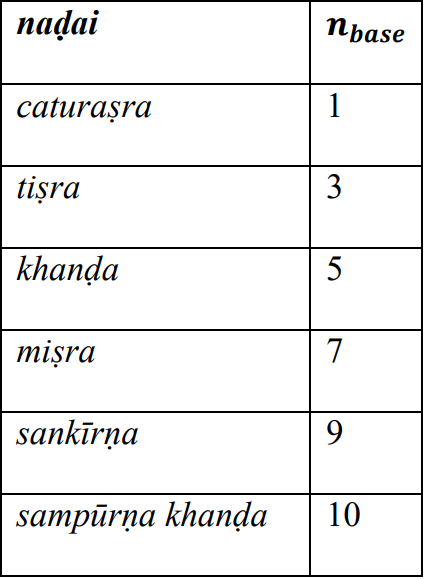
Table 1: Naḍais and their nbase values.

Figure 9: Visual model of the base speed (first speed, nspeed = 1) of various naḍais in Carnatic rhythm.
[18] Theoretically, one could even expand the above set to include additional naḍais. Although higher naḍais might lack a traditional name, the nbase integer is sufficient to describe such naḍais mathematically.
[19] From a practical perspective, we highlight that most compositions in South Indian Carnatic music are based on the caturaṣra naḍai (which corresponds to nbase = 1), for which ns = 1 x 2nspeed-1. When nspeed = 1 (first speed), we have one subdivision per beat, while nspeed = 2 (second speed) corresponds to two subdivisions per beat, nspeed = 3 (third speed) corresponds to four subdivisions per beat, and so on, as shown in Figure 10.
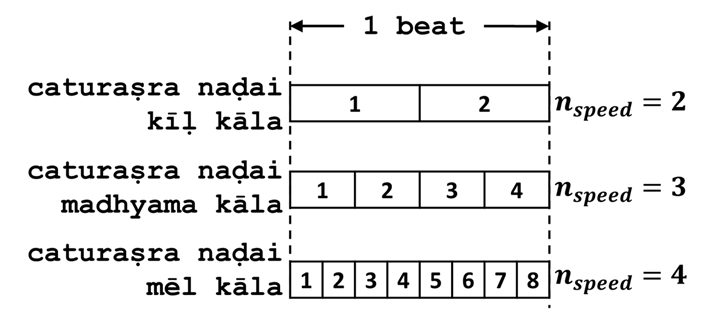
Figure 10: Visual model of speed variations in caturaṣra naḍai (kīḷ kāla, madhyama kāla, and mēl kāla).
[20] Traditionally, most reference calculations for rhythmic compositions are made with nspeed = 3, which is referred to as madhyama kāla (“intermediate speed”) and has four subdivisions per beat. When nspeed = 2, corresponding to two subdivisions per beat, we have kīḷ kāla (“lower speed”), and when nspeed = 4, corresponding to eight subdivisions per beat, the designation is mēl kāla (“higher speed”). This said, the value of nspeed that defines madhyama kāla is not universally agreed upon, as these nomenclatures have evolved mostly informally. Therefore, from a formal theoretical viewpoint, it makes sense to view the concepts of naḍai and speed as numerical entities without getting entangled in naming conventions.
[21] Before applying these naḍai and speed formulations to specific tāḷas, we should recognize that numerous tāḷas, ranging from three beats to as many as 128 beats (the simhanandana tāḷa) per cycle, contain equal beat durations. These tāḷas’ widely varying anga structures necessitate taxonomic details that are beyond the scope of this article. As discussed earlier, specialized hand and finger motions (kriyas) are used to indicate divisions within each rhythmic cycle of these tāḷas.
[22] For our rhythmic calculations, all tāḷas with equal-length beats, regardless of anga structure, are adequately described by their number of beats, nb, and the number of subdivisions within a beat, ns. The number of subdivisions is further determined by the parameters nbase (naḍai) and nspeed (speed). To generalize the approach we are developing, we adopt the following notation to name a tāḷa. We denote a tāḷa using the letter C, referring to the fact that the tāḷa defines a rhythmic Cycle, and append nb and ns as subscripts, yielding the complete name Cnb,ns. The total number of subdivisions in each rhythmic cycle is then nb x ns. For instance, for ādi tāḷa in caturaṣra naḍai (nbase = 1) and madhyama kāla (nspeed = 3), we would have eight beats (nb = 8) divided into four subdivisions each (ns = nbase2nspeed-1 = 1 x 23-1 = 4) yielding the cycle name C8,4. Thus, the total number of subdivisions per cycle is 8 x 4 = 32.
The Role of Rhythmic Compositions in Indian Classical Music: The Concept of the Kōrvai
[23] To understand the role of rhythmic and percussive compositions in a Carnatic concert, we must understand the various parts of a musical presentation. Any composition presented in a concert has the following attributes: (a) rāga, which defines a composition’s melodic framework and is marked by characteristic notes, groups of notes, and ornaments (gamakas); and (b) tāḷa, which defines a composition’s temporal framework. In addition to singing/playing a particular composition, the artists also exhibit other forms of musical creativity, such as performing precomposed passages of their own or improvising. A culmination of these creative aspects occurs in the “main item” of a concert, a composition we will call the “reference composition.” Typically, toward the midpoint of a full concert, which usually lasts for 2.5–3 hours, the leading artist begins the main presentation centered around the reference composition. Table 2 provides the details of the sequence of presentations that occur in the “main item.”
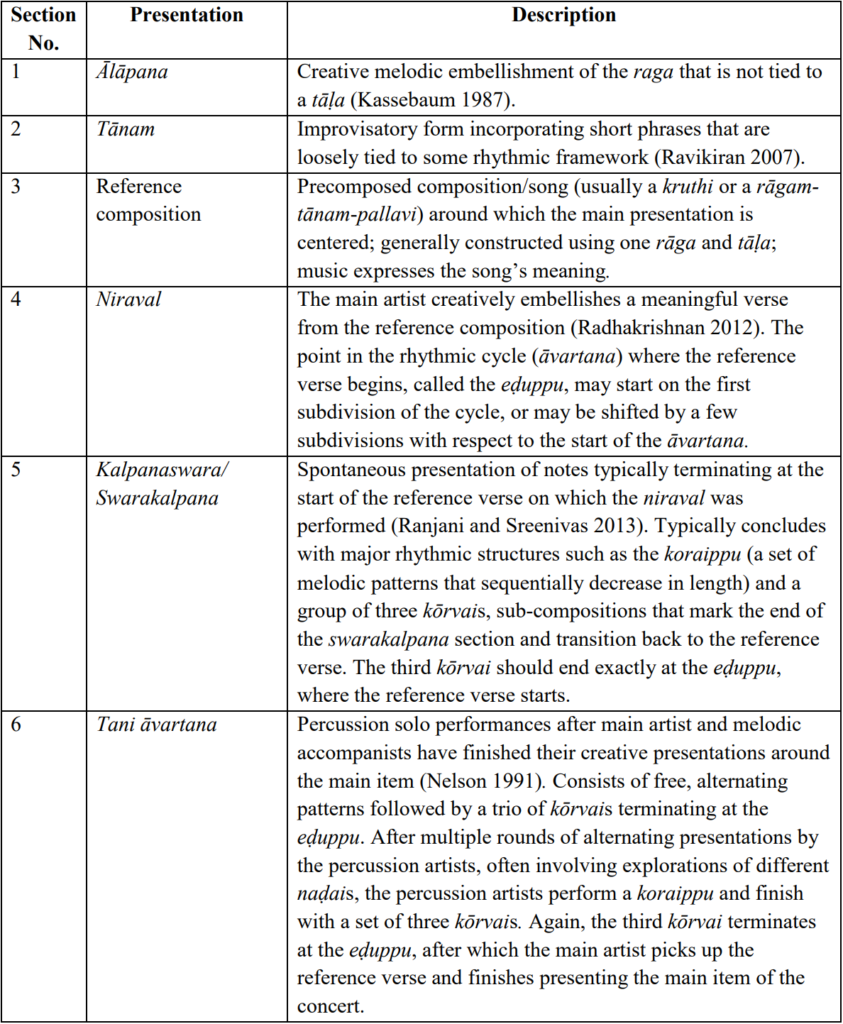
Table 2: A brief summary of a typical “main item” in a Carnatic concert. This main item could be in the form of melodic and percussive creative decorations around a reference composition, or the more detailed case of a rāgam-tānam–pallavi (beyond the scope of this paper).
[24] The last two items of the above table—the swarakalpana and the tani āvartana—involve the concept of kōrvai, which is the most important rhythmic compositional concept in Carnatic music. An artist’s quality is often measured through their ability to compose kōrvais that present rich mathematical ideas in easily understandable, elegant forms, such that the presentation is intriguing to the expert and enjoyable to the lay audience. Kōrvai composition entails some important rhythmic constraints that we consider in paragraphs [26]–[29].
The Concept of Rhythmic Offset or Eḍuppu: Atīta and Anāgata
[25] Before exploring kōrvais in greater detail, we need a precise, quantitative characterization of eḍuppu. As indicated in Table 2, the eḍuppu represents the number of subdivisions from the start of a rhythmic cycle (āvartana)that the reference verse of a composition begins. This reference verse can begin at the start of a rhythmic cycle, but also before or after. In Carnatic music, if the verse begins before the start of the rhythmic cycle, it is called an atīta eḍuppu, and if it begins after, it is called an anāgata eḍuppu. We indicate an anāgata eḍuppu of nshift subdivisions by a positive integer +nshift and an atīta eḍuppu of nshift subdivisions by a negative integer –nshift.
Current Approaches and Challenges in Carnatic Rhythmic Composition
Traditional Kōrvai Models and Constraints
[26] Kōrvais are presented in threes, as discussed in the previous section, thus forming sub-compositions of a larger tripartite rhythmic composition.[6] Traditionally, the kōrvai trio satisfies one of the following two models (Nelson 2008):
Model A: The kōrvai lengths are identical, with each sub-composition having the same total number of rhythmic subdivisions. Specifically, if each sub-composition has R (for “Rhythm”) subdivisions, the complete rhythmic composition has 3R subdivisions.
Model B:The kōrvai lengths are structured in arithmetic progression, where the three sub-compositions have R – r, R, R + r subdivisions, respectively (where r is a positive integer), again summing to 3R subdivisions overall. In the process, the parts of a kōrvai undergo arithmetically progressive modifications, as we will see in the following subsections.
[27] Conventional performance practice dictates certain constraints in the creation of rhythmic compositions.[7] These are:
Constraint 1: The rhythmic composition must end at the exact point in the rhythmic cycle (the eḍuppu, described by the integer nshift) where the reference verse of the main composition starts, so that the reference composition can start immediately after its conclusion.
Constraint 2: For cognitive simplicity, only patterns involving arithmetic numerical progressions (e.g., 1, 2, 3, 4… or 2, 5, 8, 11…, where pattern lengths increase/decrease by a constant value) should be used. (Non-arithmetic progressions such as 1, 2, 4, 8… or 0, 1, 1, 2, 3, 5… are less understandable to the listener and hence not preferred). These could be arithmetic progressions in a local context (within a single kōrvai) or in a global context (across the three kōrvais).
Constraint 3: The start of the rhythmic composition should coincide with the start of a rhythmic cycle.
Constraint 4: All subdivisions should be the same duration. This means that we are constrained to maintain the same naḍai (nbase) and speed (nspeed) throughout the rhythmic composition.
[28] Performers do not typically compromise on constraints 1 and 2. While there are cases where kōrvais can be played in different naḍais (in violation of constraint 4), the current project will respect constraint 4.[8] Constraint 3 is routinely compromised in many cases due to limitations with the current compositional approaches, as will be explained in the next section.[9] In fact, it is quite common for an artist to respect this constraint on some occasions and neglect it on others. Generally, though, the customary practice is to start a rhythmic composition (three sub-compositions) on the first subdivision of a rhythmic cycle, and only begin at a shifted position nshift (in violation of constraint 3) if necessitated by the eḍuppu.
[29] The current study, however, seeks to identify situations where it is mathematically impossible to obey constraint 3 while satisfying the other three constraints. We will remedy such situations by conceptualizing new patterns, thereby pushing the limits of rhythmic composition. The choice of respecting constraints, we believe, lies in the hands of the artist, and the subsequent execution represents the artist’s individuality. Although only constraints 1 and 2 are mandatory, we believe that imposing additional constraints, such as constraints 3 and 4, challenges an artist or composer to craft novel generative approaches to rhythmic composition. Such approaches could reflect traditional aesthetics while, ideally, being enjoyably innovative and intellectually stimulating. Another argument for the imposition of additional “creative” constraints, such as constraints 3 and 4, is that the new resulting rhythmic structures can easily be generalized to broader musical situations, including cases where constraints 1–4 are not uniformly imposed.
Traditional Internal Structure of a Rhythmic Sub-Composition or Kōrvai
[30] Before we explore more advanced conceptions of the kōrvai, including new compositional methods and patterns, a clear understanding of traditional kōrvai construction is necessary. Traditionally, the three sub-compositions that make up the rhythmic composition have an internal two-part structure. The first part is an introductory section called the pūrvārdha. The second part is a concluding section called the uttarārdha. Tables 3 and 4 summarize common structural paradigms used for the introductory and concluding parts of a sub-composition. In addition to text descriptions, we have provided illustrations to help the reader visualize the rhythmic patterns through shapes. Further, we emphasize that this is not an exhaustive list, but merely attempts to capture the basic elements of kōrvai composition as widely practiced. Many derivative structures are possible and have been implemented by numerous percussionists. Table 3 provides a semi-exhaustive list of typical pūrvārdha patterns, while Table 4 does the same for common uttarārdha patterns.[10]
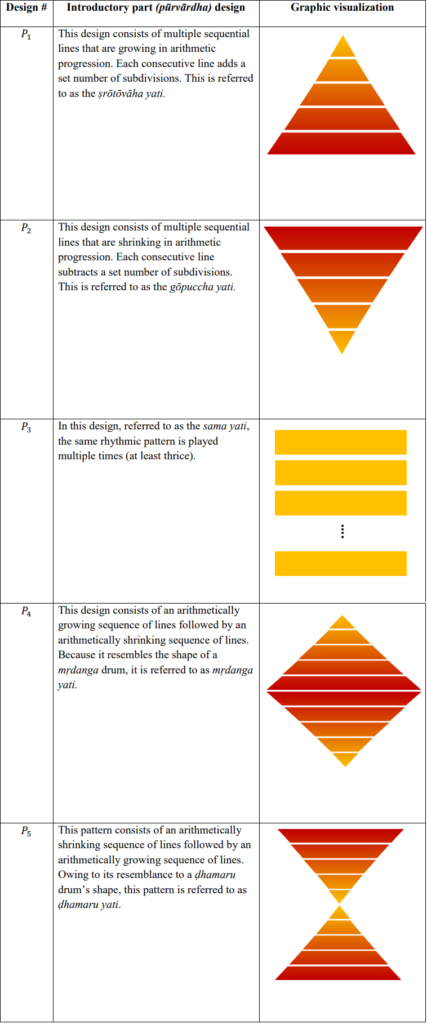
Table 3: A semi-exhaustive summary of pūrvārdha patterns in the traditional Carnatic percussive context.
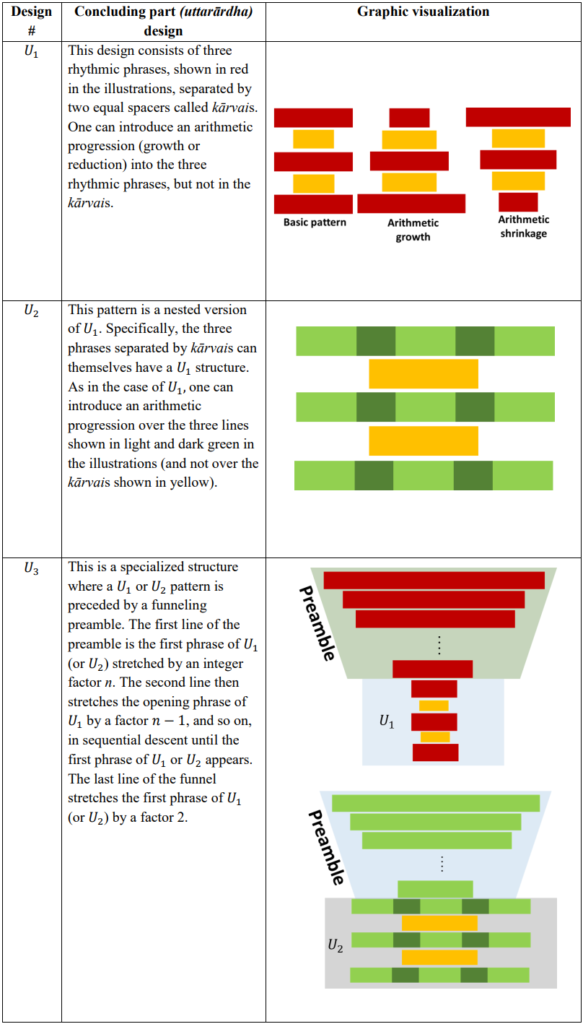
Table 4: A semi-exhaustive summary of uttarārdha patterns in the traditional Carnatic percussive context.
[31] We see from Tables 3 and 4 that arithmetic progressions can be introduced within the pūrvārdha and uttarārdha of a kōrvai. One can also apply an arithmetic progression to any of the rhythmic phrases constituting the pūrvārdha or uttarārdha across the kōrvai trio, in line with Model B described earlier in this section. Detailed mathematical representations of these pūrvārdha and uttarārdha patterns are provided in Appendix A1.
Challenges: The Case of the Cnb,ns Rhythmic Cycles where nbns = 0 (mod 3)
[32] Tables 3 and 4 demonstrate that in traditional approaches to rhythmic composition, if we assume constant naḍai, then the total number of rhythmic subdivisions across 3 kōrvais will always be a multiple of 3. This is because, irrespective of the tāḷa and the shapes chosen for the pūrvārdha and the uttarārdha, the sub-composition will be repeated thrice as part of the kōrvai trio. While not always a limitation, this property does make it impossible to design compositions in certain cases.
[33] For example, let us consider the class of rhythmic cycles Cnb,ns where the product nbns is a multiple of 3, so that each rhythmic cycle has nbns = 0 (mod 3) subdivisions. This means that the number of beats in the tāḷa and/or the number of subdivisions per beat is a multiple of 3. Now, if the reference composition starts nshift subdivisions before or after the first subdivision of the rhythmic cycle, where nshift is not a multiple of 3, then it is impossible to design a rhythmic composition using traditional approaches (i.e., Model A or B from paragraph [26]) that simultaneously satisfies all the constraints listed in previous subsections. This is because if we begin the composition at the start of the rhythmic cycle and end it nshift subdivisions before/after the start of another cycle, then the total number of subdivisions in the composition must be Ntotal = K(nbns) + nshift (where K is a positive integer), which is not a multiple of 3.[11] Specifically, the number of subdivisions spanned by a kōrvai trio would be equivalent to nshift ≠ 0 (mod 3), contradicting the aforementioned fact that a kōrvai trio’s length is always equivalent to 0 (mod 3) subdivisions. Therefore, the simultaneous satisfaction of constraint 3 and usage of traditionally derived kōrvai structures is impossible.[12]
[34] An example of such a “problem” tāḷa is C3,4—rūpaka tāḷa in caturaṣra naḍai (madhyama kāla)—which has 12 subdivisions per cycle.[13] In many musical compositions set to the C3,4 cycle, the reference composition or phrase starts 2 subdivisions before or after the start of the rhythmic cycle. In this case, Ntotal = 12K ± 2 is not a multiple of 3 and hence would pose problems.[14] We emphasize that while the number of beats is a multiple of 3 here, similar problems can arise in tāḷas having any number of beats, as long as the total number of subdivisions in a cycle is a multiple of 3 (e.g., Ādi tāḷa in tiṣra naḍai or C8,3, totalling 24 subdivisions per cycle, or miṣra cāpu tāḷa in tiṣra naḍai, totalling 21 subdivisions per cycle). While beyond the scope of this paper, problems satisfying the four aforementioned constraints could also arise in single- or multi-naḍai paradigms in which the number of subdivisions per tāḷa cycle is not a multiple of 3.[15]
[35] Conventional approaches tend to simplify the situation by relaxing constraint 3 and shifting the start of the rhythmic composition by nshift subdivisions, parallel to the reference phrase with respect to the tāḷa. One can, then, still perform a composition whose tāḷa subdivisions form a multiple of 3 because the offset of nshift (here, ±2 subdivisions) has been counteracted. For example, consider the C3,4 rhythmic cycle where we have nshift = +2 (an anāgata eḍuppu of two subdivisions), and suppose a kōrvai measures 36 subdivisions, occupying 3 āvartanas of the tāḷa. One can then shift the kōrvai to start at the relevant eḍuppu (the third subdivision of the first beat). Since the starting point has been shifted forward by 2 subdivisions, the corresponding ending point is also shifted by nshift = +2 subdivisions, allowing the rhythmic composition to conclude on the required eḍuppu. Figure 11 illustrates this with a 36-subdivision-long kōrvai whose pūrvārdha measures 21 subdivisions. This pūrvārdha is made up of three equal parts, each lasting 7 subdivisions (pūrvārdha design P3 [see Table 3]). The uttarārdha measures 15 subdivisions with three equal 5-subdivision parts (uttarārdha design U1 where x2 = 0 [see Table 4]).

Figure 11: An example of a traditional kōrvai design (Model A—see paragraph [26]) being used to compose a rhythmic trio for rūpaka tāḷa in the caturaṣra naḍai (C3,4) with an eḍuppu of nshift = +2. The pūrvārdha is shaded yellow and the uttarārdha blue, for clarity. The start of the kōrvai-trio has been shifted by +2 subdivisions corresponding to the eḍuppu.
[36] While this aesthetically successful approach has worked well for many years, efforts to identify new compositional approaches to help overcome this constraint have been limited. One set of solutions for this problem takes the form of what artist Chitravina Ravikiran calls “keyless kōrvais” (Ravikiran 2015). However, Ravikiran admits to having “literally stumbled upon” most of the solutions (presumably via trial and error), making the approach difficult to codify. Moreover, while some of his new kōrvais are easily comprehensible for both lay and expert listeners, other kōrvais’ complexity would create a significant obstacle for non-expert listeners. These considerations suggest the need for algorithmic intervention to codify new rhythmic structures that adhere closely to traditional aesthetics while pushing compositional boundaries. Such a deterministic, semi-algorithmic approach would allow us to move beyond mere trial and error. Moreover, incorporating all four aforementioned constraints, including constraint 3, when generating new rhythmic designs would lead to musically significant compositions that appeal to lay listeners and experts alike.
[37] Algorithmic musical compositions have been a popular topic of research in Carnatic music (Moroni et al. 2000).[16] However, these algorithms are not straightforward, and they involve musical aspects that vary between composers, performers, audiences, and social contexts. Algorithmic designs that involve training a machine to mimic the human brain (Chan, Potter, and Schubert 2006) offer one solution to the problems of variability and complexity. Automated music generation in Carnatic music carries the added challenge of having to encompass complex aspects such as gamakas (melodic ornamentation) and idiomatic rhythmic patterns (Garani and Seshadri 2019). This said, there are ample possibilities in the percussion realm for machine-generated music, the exploration of which is currently in preliminary stages (Trochidis, Guedes, and Anantapadmanabhan 2017; Trochidis et al. 2016). There is, therefore, prior precedent for our algorithmic development of newer patterns that can overcome the aforementioned issues while satisfying the constraints given in paragraph [27].
Aesthetic Requirements of Novel Approaches
[38] We have identified a need to develop newer deterministic strategies to compose rhythmic pieces bound by the four aesthetic constraints listed above. The algorithmic approach should facilitate designing new patterns that have progressive behavior, but whose total subdivisions do not sum to a multiple of three. A simple arithmetic-progression-based rhythmic structuring, either locally or in a global sense (as in Model B from paragraph [26]) with respect to a kōrvai, is inadequate. Thus, in the next section, we conceptualize patterns whose aesthetic basis is still the arithmetic progression, but whose internal structure breaks the multiplicity with three. Further, for various traditional and aesthetic reasons, it is important for the pūrvārdha and the uttarārdha to consist of a minimum of three rhythmic phrases (equal, sequentially growing, or sequentially shrinking in size).[17] This will ensure that the newly developed patterns are backward-compatible with the schemes that have evolved over years of percussive practice. We impose the above 3-subpattern minimum as an additional requirement beyond the four previously discussed constraints of kōrvai composition.
A Deterministic Approach to Rhythmic Compositions
New Progressive Patterns: Core Design Principle
[39] As previously indicated, the problem with the current approach to rhythmic compositions is that the total number of subdivisions in a kōrvai trio is always a multiple of three. This would not allow us to simultaneously satisfy all constraints laid out paragraph [27] for the Cnb, ns (nbns = 0 (mod 3)) family of tāḷas having eḍuppus nshift ≠ 0 (mod 3). In designing new patterns, then, we must use arithmetically progressive patterns that break the multiplicity with three. We achieve this by introducing cumulative progressions rather than simple arithmetic progressions. Namely, each of our novel rhythmic designs will contain a component that steadily grows/shrinks across three kōrvais. This progressive growth/shrinking maintains an arithmetic pattern while breaking the multiplicity with 3. In the following subsections, we describe how to construct these new compositional designs.
Proof-Of-Concept Examples
[40] We demonstrate our novel compositional strategy using two rhythmic designs that introduce a non-multiple-of-three component into the kōrvai trio. In the first design, this new component is applied to the pūrvārdha of the kōrvai and in the second, to the uttarārdha. We illustrate the two designs using the C3,4 rhythmic cycle with nshift = +2 (anāgata eḍuppu of two subdivisions) and nshift = –2 (atīta eḍuppu of two subdivisions), respectively. These two cases correspond to reference compositions starting on the third and eleventh subdivisions, respectively, of the C3,4 cycle measuring twelve subdivisions. We choose these eḍuppus as illustrative examples because of their use in numerous Carnatic compositions. This said, the rhythmic conceptualizations and algorithmic approach developed here are applicable to all periodic rhythmic constructs, including the cāpu tāḷas.
Design 1: Cumulatively Progressive Pūrvārdhas
[41] Figure 12 shows the proposed structure of the pūrvārdhas and the uttarārdhas of the three kōrvais with the aforementioned cumulatively progressive component applied in the pūrvārdha. In the figure, the melodic/rhythmic units forming the pūrvārdhas (described below) have lengths a1 and a2, while those forming the uttarārdhas have lengths x1 and x2, respectively. Table 5 summarizes the resulting subdivision counts for each internal pattern. For context, recall that in a more traditional kōrvai trio, the sequence of pūrvārdhas would have been (3a1 – rp, 3a1, 3a1 + rp) for some integer rp ≥ 0.

Figure 12: A geometric representation of the pūrvārdha and uttarārdha of the three kōrvais with the first newly proposed rhythmic composition structure (“Design 1”).

Table 5: Subdivision counts for the pūrvārdha and uttarārdha of the 3 kōrvais forming the Design 1 rhythmic composition trio.
[42] The base pattern for the introductory section is a trio of identical phrases having a1 subdivisions each, yielding 3a1 subdivisions total. When played just once, the pattern is aesthetically complete (resembling pūrvārdha design P3) due to the triple repetition, while also allowing cumulative growth in the subsequent kōrvais. This base pattern is the pūrvārdha of the first kōrvai of the series. The subsequent kōrvais incorporate added phrases between statements of the 3a1 base pattern. In the second kōrvai, two 3a1 base patterns are separated by a phrase of length a2, while in the third kōrvai, three base patterns are separated by phrases of length a2 and 2a2 subdivisions, respectively. These additional phrases will be the crux of the new compositional designs because they break the multiplicity with three. The uttarārdha is the same in all three sub-compositions, consisting of Design U1 (3x1 + 2x2 subdivisions).
[43] In this example, the total number of subdivisions of the three uttarārdhas together is a multiple of 3. However, the total number of subdivisions across the three pūrvārdhas is not necessarily a multiple of 3. This is because of the introduction of the progressively increasing component a2, which contributes 4a2 total subdivisions across the three kōrvais. With these added components, the rhythmic composition now satisfies all previously mentioned constraints (constraints 1–4) and the aesthetic requirements laid out in paragraph [38]. We have a progressively growing (or shrinking) pūrvārdha as we move through the three sub-compositions, while maintaining the same uttarārdha. Furthermore, we have used only arithmetically progressive patterns.
[44] The total number of subdivisions in the rhythmic composition will then be 18a1 + 4a2 + 9x1 + 6x2). The constraint equation that needs to be satisfied, for a rhythmic cycle Cnb, ns with reference eḍuppu nshift, is 18a1 + 4a2 + 9x1 + 6x2 = (nbns)Ncycles ± nshift.
[45] The right side of the equation presents an alternative formula for the number of subdivisions in the rhythmic composition, where nbns represents the number of subdivisions in a single āvartana, and Ncycles is the number of complete tāḷa cycles contained in the composition. The right side thus represents the total number of subdivisions as Ncycles complete cycles (for some whole number Ncycles) containing (nbns)Ncycles subdivisions, plus or minus the desired eḍuppu offset of nshift subdivisions.
Design 2: Cumulatively Progressive Uttarārdhas
[46] Our second design introduces cumulative progression into the uttarārdha. The uttarārdha is based on design U2 (see Table 4), but incorporates cumulative growth over the three kōrvais. Figure 13 and Table 6 show the structures of the new sub-compositions. The introductory pattern is simple and consists of three equal, repeating phrases.
[47] Following a similar approach as for Design 1, we get the constraint equation 9a1 + 18x1 + 12x2 + 8x3 = (nbns)Ncycles + nshift.

Figure 13: A geometric representation of the pūrvārdha and uttarārdha of the three kōrvais of the second newly proposed rhythmic composition structure (Design 2).

Table 6: Subdivision totals for the pūrvārdha (introductory part) and uttarārdha (concluding part) of the three kōrvais forming the Design 2 rhythmic composition trio.
[48] The introduction of the progressively growing intermediary component x3 into the uttarārdha contributes a total of 8x3 subdivisions across the kōrvai trio, which is not always a multiple of three and hence can potentially yield solutions to the challenges involving the C3,4 rhythmic cycle with eḍuppu nshift = ±2.
Concept Exemplification with 3-Beat Rhythmic Cycles
[49] In this subsection, we exemplify the algorithmic construction of kōrvais based on Designs 1 and 2 above for the C3,4 rhythmic cycle with nshift = ±2 eḍuppus. The general procedure involves setting up a linear multivariable equation where the independent variables are the kōrvai components and the dependent variable, for which we solve, is Ncycles, the number of complete rhythmic cycles consumed by the three kōrvais when the nshift offset is excluded.This equation is solved, and acceptable solutions are extracted algorithmically through a simple code written and executed using MATLAB. Carnatic vocal demonstrations of the examples that follow in Figures 14–17 are provided in the Appendix A2. These include sung performances (Video Examples 1, 2, 3, and 4) of the designs, showing how these kōrvais might be used in non-percussive contexts, and annotated transcriptions in sargam and Western staff notation.
Exemplification of Design 1 for the Rhythmic Cycle with 2-Subdivision Eḍuppus
[50] Applying Design 1 to rūpaka tāḷa (C3,4) with an eḍuppu of nshift = ±2, we get 18a1 + 4a2 + 9x1 + 6x2 = 12Ncycles ± 2.
In the first case where nshift = +2, the rhythmic composition will be two subdivisions longer than Ncycles rhythmic cycles, and in the case where nshift = –2, the rhythmic composition will be two subdivisions shorter than the Ncycles rhythmic cycles.
The adopted algorithm is as follows:
Step 1: Prescribe desired values for the uttarārdha parameters x1 and x2.
Step 2: Prescribe a range of positive integer values for the pūrvārdha parameters a1 and a2.
Step 3: Solve for the unknown Ncycles and obtain the set of all solutions S for the prescribed range of the independent variables. We represent the ith element of this set by si = [a1(i), a2(i), x1(i), x2(i), Ncycles(i)], so that si is an array carrying the prescribed and solved parameters for the kōrvai.
Step 4: Obtain the subset of solutions sint such that Ncycles is a positive integer. Specifically, sint = { si | si ∈ S and Ncycles(i) = floor(Ncycles(i))}, where floor(x) is the greatest integer that is less than or equal to x.
Step 5: Compose the kōrvai with structure determined by a1, a2, x1, and x2, from a chosen sint solution.
[51] For illustrative purposes, we set x1 = 18, x2 = 1 as our uttarārdha values in Step 1.
[52] We set the range of a1 and a2, our pūrvārdha values, as Ra1a2 = {a1, a2 ∈ ꓜ: 1 ≤ a1 ≤ 8, 1 ≤ a2 ≤ 5}, where ꓜ is the set of integers. The values of a1 and a2 that lead to an integer solution to Ncycles are tabulated in Table 7 for both cases, nshift = ±2.
[53] The shaded rows in Table 7 are the solutions that we will demonstrate via musical examples. Specifically, sample rhythmic compositions corresponding to these solutions for eḍuppus nshift = 2 and nshift = –2 are notated below in Figure 14 and Figure 15, respectively (again, see Appendix A2 for vocal recordings and annotated transcriptions). Especially note the role of the light blue boxes, which represent the novel a2 phrases in the pūrvārdha.

Table 7: Acceptable solutions to kōrvais based on Design 1 for C3,4 rhythmic cycles, with nshift = ±2. The values of x1 and x2 are prescribed as 18 and 1, for demonstrative purposes, and are not shown in the table.

Figure 14: Kōrvai trios based on Design 1 for the C3,4 rhythmic cycle (rūpaka tāḷa) with an anāgata eḍuppu, nshift = +2. The composition starts on the first subdivision of the first beat and ends two subdivisions into the first beat. Dark blue color indicates the introductory pattern measuring 3a1 subdivisions. Light blue indicates the intervals a2 and 2a2 introduced in the pūrvārdha of the second and the third kōrvais, respectively, as per Design 1. The yellow and red cells indicate the x1 and x2 portions of the uttarārdha, respectively. The composition finishes in the 23rd rhythmic cycle (after completing 22 complete cycles).

Figure 15: Kōrvai trios based on Design 1 for the C3,4 rhythmic cycle (rūpaka tāḷa) with an atīta eḍuppu, nshift = –2. The composition starts on the first subdivision of the cycle and ends two subdivisions before the end of the rhythmic cycle. Dark blue indicates the introductory pattern measuring 3a1 subdivisions. Light blue indicates the intervals a2 and 2a2 in the pūrvārdha of the second and the third kōrvais, respectively, as per Design 1. The yellow and red cells indicate the x1 and x2 portions of the uttarārdha, respectively. The composition finishes in the 23rd rhythmic cycle (after completing 23 complete cycles minus two subdivisions).
Exemplification of Design 2 for the C3,4 Rhythmic Cycle with 2-Subdivision Eḍuppus
[54] For the rhythmic cycle C3,4 and nshift = ±2, we have the constraint equation 9a1 + 18x1 + 12x2 + 8x3 = 12Ncycles ± 2.
The algorithm here works as follows:
Step 1: Choose desired values for a1, x2 and x3. Recall that a1 is the length of the basic phrase defining the pūrvārdha, while x2 and x3 are the intermediary phrase lengths in the uttarārdha.
Step 2: Prescribe a range of positive integer values for the initial phrase, x1, of the uttarārdha.
Step 3: Solve for the unknown Ncycles and obtain the set of all solutions S for the prescribed range of the independent variable x1. We will represent the ith element of this set as si = [a1(i), x1(i), x2(i), x3(i), Ncycles(i)], so that si is an array containing the prescribed and solved parameters of the kōrvai.
Step 4: Obtain the subset of solutions sint for which Ncycles is a positive integer. Specifically, sint = { si | si ∈ S and Ncycles(i) = floor(Ncycles(i))}, where floor(x) is the greatest integer that is less than or equal to x.
Step 5: Compose the kōrvai with structure determined by a1, x1, x2, and x3 from a chosen Sint solution.
For our illustration, we choose a1 = 8, x2 = 0, and x3 = 1 for nshift = +2, and x3 = 2 for nshift = –2. We obtain the acceptable solutions given in Table 8 for x1 in the range Rx1 = {x1 ∈ ꓜ: 5 ≤ x1 ≤ 9}.
Figures 16 and 17 then adapt the highlighted solutions from Table 8 to form sample rhythmic compositions (see Appendix A2 for recordings and transcriptions).
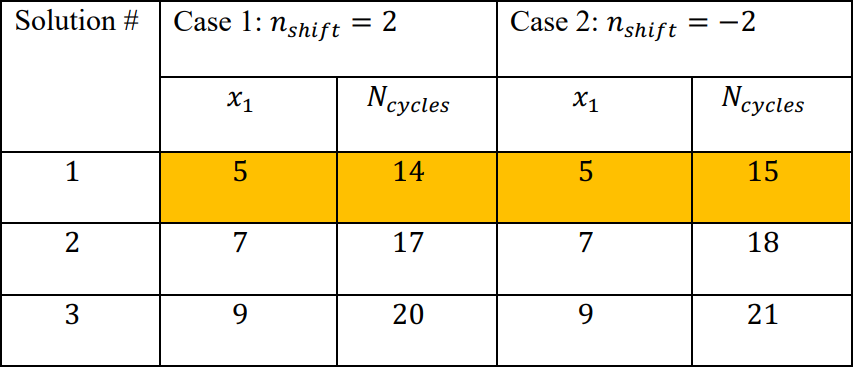
Table 8: Acceptable solutions to kōrvais based on Design 2 for C3,4 rhythmic cycles, with nshift = ±2. The values of a1, x2, and x3 are prescribed as a1 = 8, x2 = 0, and x3 = 1 (for nshift = +2) and x3 = 2 (for nshift = –2) for demonstrative purposes, and are not shown in the table.
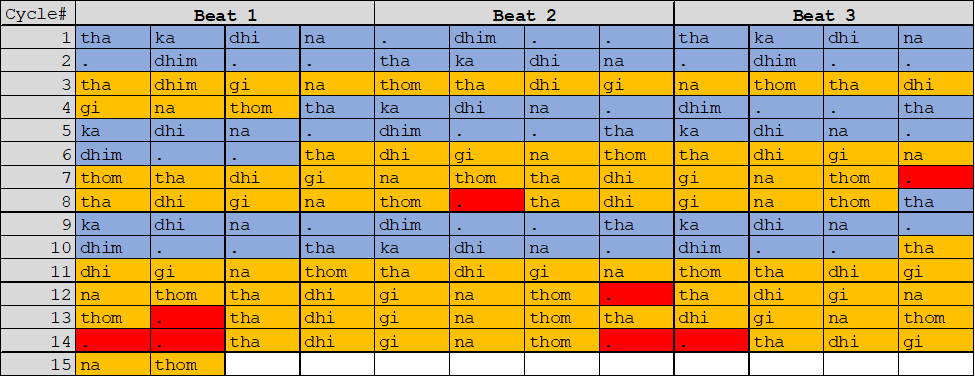
Figure 16: Kōrvai trios based on Design 2 for the C3,4 rhythmic cycle (rūpaka tāḷa) with an anāgata eḍuppu, nshift = +2. The composition starts on the first subdivision of the cycle and ends two subdivisions into the first beat of the cycle. Blue indicates the pūrvārdha, yellow indicates the (3x1 + 2x2)-subdivision building block of the uttarārdha, and red cells indicate the x3 component of the uttarārdha, respectively. The composition finishes in the fifteenth rhythmic cycle (after completing fourteen complete cycles).
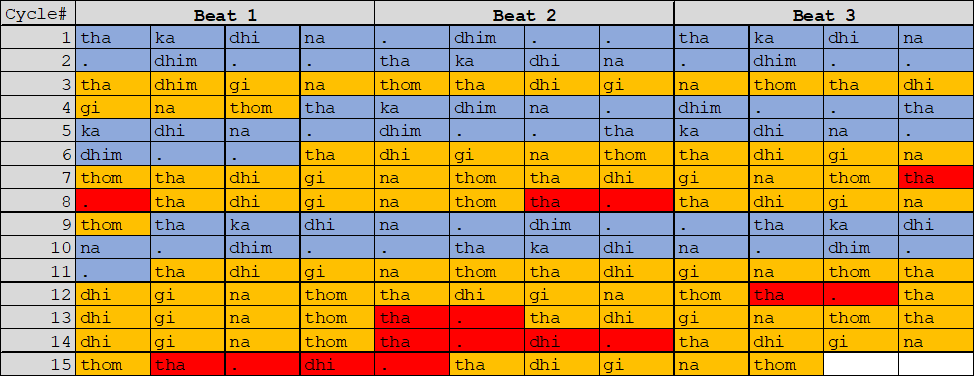
Figure 17: Kōrvai trios based on Design 2 for the C3,4 rhythmic cycle (rūpaka tāḷa) with an atīta eḍuppu, nshift = –2. Note that the composition starts on the first subdivision of the cycle and ends two subdivisions before the end of the cycle, as required. Blue indicates the introductory pattern. The yellow cells indicate the (3x1 + 2x2)-subdivision building block of the uttarārdha and red cells indicate the x3 components introduced in the uttarārdha, respectively. The composition finishes in the fifteenth rhythmic cycle (after completing fifteen complete cycles minus two subdivisions corresponding to the eḍuppu).
Generalizing the Approach
[55] A generalized approach to the above designs would involve a combination of artistry and algorithmic thinking, as graphically depicted in Figure 18. The process steps highlighted in blue can be implemented through software.
Compositional Applications Beyond Carnatic Music
Introduction and Motivations
[56] The demonstrations in the previous section have exclusively considered our new rhythmic designs in the context of Carnatic music. Indeed, within Carnatic music, these novel theories offer innumerable new possibilities for the solo vocalist or instrumentalist. An interesting question, though, is whether these theories about kōrvai structure could have applications beyond South Indian classical music.
[57] A primary motivation for the latter question is that Carnatic techniques have already been applied to jazz and funk improvisation (Krishnamurthy 2015), jazz-based art music (Young 2015; Okazaki 2006; Takeno 2017), Indian hip hop (Akundi 2021), and other examples of musical fusion. Additionally, numerous musicians and composers have explored how Indian music could interact with Western classical music. Examples include Olivier Messiaen’s adaptation of Śārṅgadeva’s (1175-1247) deśitāḷas to rhythms in his contemporary compositions (Šimundža 1987), and Philip Glass’s Indian-inspired works such as the opera Satyagraha and the oratorio The Passion of Ramakrishna, influenced by a formative period when Glass worked as sitarist Ravi Shankar’s assistant (Glass 2015). A more theoretically based approach to Indian/Western classical fusion comes from Chitravina Ravikiran and Robert Morris, whose concept of “melharmony” allows Carnatic rāgas to be harmonized using notes of the rāga, in a manner that respects the inherent properties of individual rāgas (Morris and Ravikiran 2006; Ravikiran 2014).

Figure 18: A generic process flow for algorithmic kōrvai composition in any tāḷa (Cnb, ns rhythmic cyle) for a required eḍuppu given by nshift.
[58] These examples strongly suggest that the current research on kōrvai structures could have applications to other musical styles. Indeed, since the kōrvai is a rhythmic/metric structure, it could be used to ground a wide variety of melodic, harmonic, and timbral combinations and uses. An apparent challenge, though, is that our discussion thus far has depended on assumptions about musical structure specific to Carnatic music-making, as demonstrated by the kōrvai models and constraints from paragraphs [26]–[29] above. How could the current research be applicable in musical situations in which these constraints are no longer assumed, such as contemporary Western art music where compositional aesthetics can vary widely? The next subsection considers this question in detail.
Compositional Philosophy
[59] Applying this study’s new kōrvai theories to other musical styles requires careful consideration of compositional philosophy. Namely, the kōrvai models and constraints described previously, such as the principle of arithmetic rhythmic progression between sub-compositions and the requirement that a kōrvai trio end exactly where a referential melody begins, are fundamental to Carnatic rhythm but absent from many other musical traditions. As such, if the kōrvai constraints are to apply in these new contexts, they must be externally imposed. This imposition of constraints would be for artistic purposes rather than traditional precedent.
[60] A non-Carnatic composer or performer may wonder why we might impose such constraints on a composition or improvisation. It is important to acknowledge, though, that composition and improvisation already bear implicit constraints, even in seemingly open-ended Western styles. Jazz, for instance, has an air of freedom, but improvising soloists are constrained by the chord changes given in the lead sheet and rules about what melodic notes “agree” with a given chord. Atonal art music from the first half of the twentieth century is not obligated to follow the harmonic rules of earlier eras, but conventional instrumental timbres and equally-tempered tuning are often assumed.[18]
[61] Moreover, in the early twentieth century, atonal composers began turning to serial techniques, using mathematical principles to structure melody, harmony, and contrapuntal lines. These techniques allowed composers to organize their new musical sounds using externally imposed structures, thus illustrating the powerful role that imposed constraints might play in certain Western compositional or improvisational contexts.[19] By extension, the constraints inherent in Carnatic music could be intentionally and strategically applied to composition in other musical realms, even if the non-rhythmic parameters such as melody, harmony, and timbre vary substantially from Indian classical norms.
[62] This said, composers and improvisers interested in applying Carnatic principles to non-Carnatic music should avoid doing so haphazardly. The authors of the current study strongly recommend careful study of traditional Indian classical music in any such endeavor, which would ideally involve not just reading about Carnatic music theory, but listening to real musical performances and having conversations with practitioners of Carnatic music. In this way, a composer can explore new compositional territory while respecting the deep musical traditions undergirding these compositional constraints.
Applying the Theories in Non-Carnatic Settings
General Strategies
[63] There are many ways one might adapt Carnatic principles to other musical idioms. The goals of the forthcoming demonstrations, however, are specific and limited: we aim to apply the four constraints from paragraph [27], and the new kōrvai structures of paragraphs [39]–[55], to composing Western-classical-style music. Numerous other adaptations of Carnatic principles are possible, but are beyond the scope of this limited study.
[64] To incorporate our novel kōrvai structures into a Western classical composition, the first necessary component is a distinct musical theme that can serve as a point of departure. In Carnatic music, this would be a referential musical line to which a composition consistently returns. As discussed previously, the point in the tāḷa where this referential line begins defines the eḍuppu, which serves as a “landing point” for a kōrvai trio—i.e., the last kōrvai must end exactly where the referential phrase begins.
[65] The calculations in paragraphs [49]–[55] investigated eḍuppus that are located some nonzero distance from the start of a tāḷa cycle. As such, in the compositional demonstrations to follow, we opt to begin our main themes on rhythmic locations other than the downbeat. The starting rhythmic location should always be chosen carefully and intentionally, as even a slight change in this location can have a drastic effect on the possible kōrvai structures.
[66] Once the main theme has been composed, a composer can consider the broad scope of the composition, including the overall length, number of sections, and so forth. Within this compositional plan, the main theme, after being stated early in the composition, should ideally return at least once. Then, any time this theme returns, the composer can precede it with a kōrvai, thereby generating rhythmic tension and interest leading to the theme’s entrance. For instance, in a jazz-influenced composition, the kōrvai could lead from an instrumental solo to the return of the head. In a movement in classical sonata form, the kōrvai might build intensity at the end of the development section and carry the music smoothly into the recapitulation. In a solo percussion piece, the kōrvai might lead to the return of an opening groove.
[67] Regardless of the specific musical style or form, the rhythmic structure of the kōrvai can be determined using the method given in Figure 18. Namely, user-defined values can dictate the length of each phrase/section of the kōrvai, and once these are set, composition can begin. A new question then emerges: how closely should the compositional use of the kōrvai align with Carnatic norms?
[68] In particular, we might envision a spectrum from close adherence to Carnatic principles to much looser adherence. At the first end of the spectrum could be melodically driven music that incorporates traditional Carnatic rhythmic patterns and approximates melodic motions within a specific Carnatic rāga.[20] At the other end, we might have a composition that implements kōrvai structures to depart from an established meter, but does not attempt to incorporate accepted Carnatic rhythmic patterns, melodic phrases, or rāgas. Between these two extremes lie various shadings. For instance, a kōrvai might incorporate typical Carnatic rhythmic patterns but use non-Carnatic scales or modes instead of rāgas. A kōrvai trio could even start at one end of the spectrum and move to the other as the music progresses—for instance, by starting fairly traditionally, and deviating from Carnatic expectations as the return of the main theme approaches.
[69] A composer could also adapt the kōrvai structure to precede a musical theme that is not the main theme. The composer would need to recognize, though, that this would be a more significant departure from Carnatic tradition. Again, ethical considerations are warranted here, and composers should be careful, when departing from Carnatic norms, that they do not do so thoughtlessly. The better understanding one has of Carnatic music, the more effectively and respectfully they can incorporate kōrvai structures into other musical contexts.
Examples
[70] To illustrate the above principles, we provide two musical examples illustrating how our novel kōrvai structures might be used in non-Carnatic settings. These obviously only provide a preliminary taste of how these kōrvais could be applied to other musical styles, but they are valuable in suggesting possible routes a composer might follow.
[71] In the previous subsection, we argued that applications of Carnatic techniques to non-Carnatic music conceptually occur on a continuum: at one extreme is music that departs very little from South Indian classical traditions, while the other end contains music that only loosely draws on Carnatic norms. Figure 19 (and Audio Examples 1 and 2) present two excerpts from a hypothetical solo oboe composition that stays, in certain respects, fairly close to Carnatic expectations.
[72] This would-be composition is based on the Western musical theme La Folia, shown in Figure 19a. After stating the main theme, the composer could proceed in numerous directions, such as a set of variations on La Folia or a series of contrasting sections.
[73] In either case, suppose the composer eventually pulls the music into a state of increased virtuosity and musical tension, in preparation for a triumphant return of the original La Folia theme. As shown in Figure 19b, such a section could easily house a kōrvai structure. Because the main theme starts with an eighth-note pickup, or two sixteenth-note subdivisions, we incorporate a kōrvai design where nshift = –2.

Figure 19: Hypothetical oboe composition: opening theme and kōrvai implementation.
[74] This kōrvai trio stays close to Carnatic expectations, at least from a rhythmic standpoint, as the rhythms are based on traditional solkaṭṭu patterns. In particular, these rhythms are taken directly from Design 2, nshift = –2 (Figure 17). Melodically, however, the excerpt is not based on an Indian classical rāga, but the Western A minor scale.[21] Furthermore, the melody suggests Western harmonic expectations due to the arpeggiated chords and sequential melodic figures. Nevertheless, the kōrvai concludes in a quasi-Carnatic manner, ending precisely where the La Folia theme returns and marking the conclusion of a difficult, highly technical section of the piece.
[75] Figures 20–21 (and Audio Examples 3 and 4) present a different approach to adapting our new kōrvai structures to non-Carnatic music. Instead of a melodic composition for a solo wind instrument, this example consists of a harmonically driven piece for piano solo.
[76] The main theme of the piece, shown in Figure 20a, starts two eighth notes before the downbeat. Thus, we again have an nshift = –2 scenario, albeit in a different notated meter. Unlike the oboe solo, this hypothetical composition has multiple simultaneous musical lines, creating a sound world of contemporary harmony and counterpoint. Already, the primacy of harmony and changing chords, rather than melody, makes this piece decided less Carnatic in character than the oboe piece. Additionally, rather than being based on a single scale and pitch center, this piece implements two different Western modes, each with a different tonic note (namely, D Dorian and E-flat Lydian).
[77] Pushing the composition even further from Carnatic norms is the kōrvai trio shown in Figures 20b–21. While all main sections of the kōrvai are still present, the pūrvārdha rhythms from Figure 17 have been placed in the left hand of the piano. As such, rather than being soloistically foregrounded, these rhythms are initially pushed to the background. The right hand, meanwhile, plays a series of long chords over the pūrvārdha rhythms.
[78] In the uttarārdha, the musical dynamic changes. Neither hand attempts to incorporate rhythms from Figure 17; instead, we have new rhythmic phrases spanning the desired number of subdivisions. Moreover, the melodic gestures in the right hand incorporate rhythmic values that are faster than the kōrvai’s minimal rhythmic value (here represented by the eighth note), thereby subverting constraint 4 from paragraph [27]. Finally, and more holistically, the scalar and chordal techniques used here are idiomatic to the piano, giving the piece a sound distinct from that of classical Carnatic instrumental playing.
[79] In sum, this piano composition incorporates the kōrvai structure much more freely than the oboe piece, and is therefore further removed from Carnatic tradition. In both hypothetical compositions, though, the spirit of the kōrvai as forming a rhythmically intricate ending to a section and leading back to a recognizable melody is retained. Moreover, imposing the new kōrvaisas a musical constraint in these decidedly non-Carnatic pieces has paved the way to novel compositional possibilities. When used in such contexts, these kōrvai structures create an idiosyncratic fusion of Indian and Western classical aesthetics and thus represent a unique form of intercultural dialogue.

Figure 20: Hypothetical piano composition: opening theme and start of kōrvai.
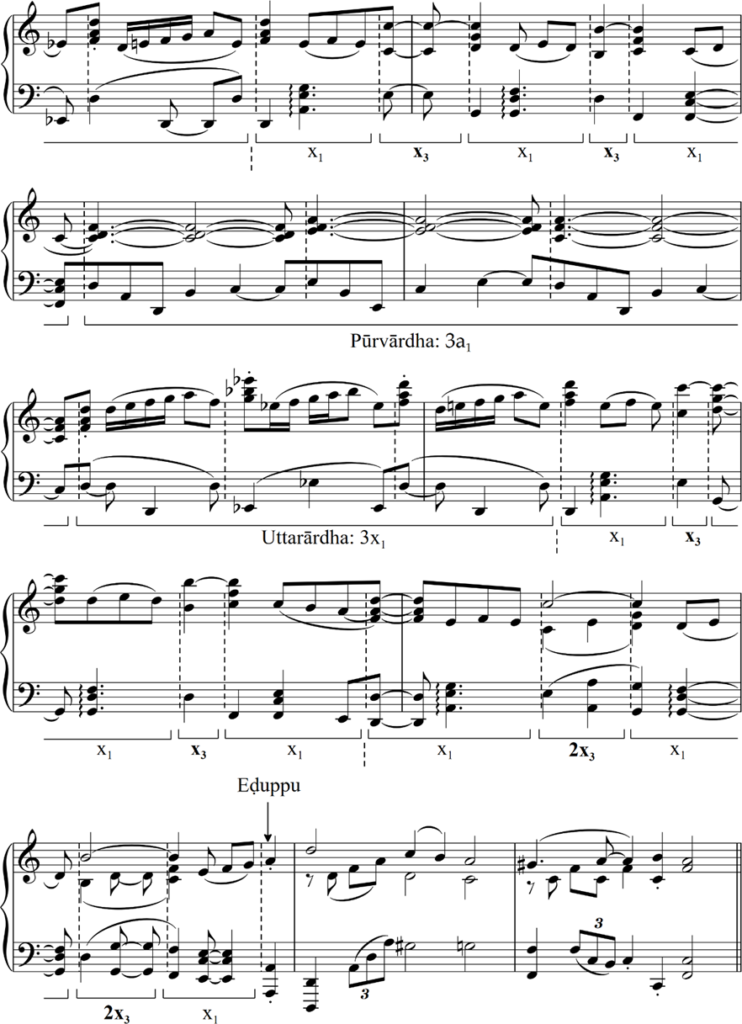
Figure 21: End of kōrvai leading to eḍuppu in hypothetical piano piece.
Summary and Outlook
[80] We have demonstrated a key step toward algorithmic rhythmic composition in the context of Carnatic music through a systematic approach involving the following: (a) clarifying, and mathematically modeling, essential rhythmic constructs and concepts and their place in the scheme of a Carnatic music concert; (b) highlighting the limitations of existing traditional approaches to rhythmic composition in Carnatic music; (c) conceptualizing and algorithmically determining new rhythmic designs to address the limitations of traditional rhythmic constructs; and (d) musically demonstrating the proposed designs in the context of Carnatic percussive/vocal music and hypothetical non-Carnatic compositions. We believe that this generative approach to kōrvai structure and substructure, and the approach’s potential extensions, can lead to significant strides in rhythmic compositional complexity in Carnatic music and beyond.
Acknowledgments
Dr. Krishnaswamy thanks his mridangam guru Vidwan Nagaragere Gangadhara Ravi (Bangalore, India) for initiating him into the challenge of composing kōrvais within the precise constraints presented in this paper. Dr. Krishnaswamy also thanks senior khanjira Vidwan N. Amrit (Bangalore, India) for the traditional and aesthetic whetting of the algorithmic approaches developed here. Dr. Wells thanks the numerous teachers and scholars of Carnatic music who have shaped his understanding of this beautiful music, including (but not limited to) Rohan Krishnamurthy, Robert Morris, and Sangeetha Agarwal.
References
Akundi, Sweta. 2021. “The Carnatic Hip Hop Wave Is Rising, and the Mridangam is at the Centre of It.” The Hindu, July 15, 2021. https://www.thehindu.com/entertainment/music/carnatic-hip-hop-with-mridangam-beats-rapping-to-konnakol-style/article35337227.ece.
Chan, Heidi. 2013. “Exploring Nadai–The Concept of Beat Subdivision in South Indian Music.” Principles of Music Composing: The Phenomenon of Rhythm, 13th International Music Theory Conference, Vilnius XIII: 118.
Chan, Michael, John Potter, and Emery Schubert. 2006. “Improving algorithmic music composition with machine learning.” Paper presented at the 9th International Conference on Music Perception and Cognition, August 22–26, 2006.
Cope, David. 2015. “Algorithmic music composition.” Patterns of Intuition: Musical Creativity in the Light of Algorithmic Composition, ed. Gerhard Nierhaus, 405–416. Dordrecht: Springer.
Garani, Shayan Srinivasa, and Harish Seshadri. 2019. “An Algorithmic Approach to South Indian Classical Music.” Journal of Mathematics and Music 13(2): 107–34.
Glass, Philip. 2016. Words Without Music: A Memoir. New York; London: Liveright Publishing Corporation.
Kassebaum, Gayathri Rajapur. 1987. “Improvisation in alapana performance: A comparative view of raga Shankarabharana.” Yearbook for Traditional Music 19: 45–64.
Krishnamurthy, Rohan. 2015. “The Alaya Project.” Rohan Krishnamurthy (website). Accessed 12 May, 2022. http://www.rohanrhythm.com/thealayaproject.
———. 2021. “San Francisco Community Music Center Rhythm Workshops, Winter 2021.” Unpublished manuscript, last modified 22 January, 2021. Google Doc.
Lerdahl, Fred, and Ray Jackendoff. 1983. A Generative Theory of Tonal Music. Cambridge, Mass.: MIT Press.
Moroni, Artemis, Jônatas Manzolli, Fernando Von Zuben, and Ricardo Gudwin. 2000. “Vox populi: An interactive evolutionary system for algorithmic music composition.” Leonardo Music Journal 10: 49–54.
Morris, Robert, and Chitravina N. Ravikiran. 2006. “Ravikiran’s Concept of Melharmony: An Inquiry into Harmony in South Indian Ragas.” Music Theory Spectrum 28 (2): 255–76.
Nelson, David P. 1991. “‘Mrdangam’ Mind: The ‘Tani Avartanam’ in Karnatak Music (Volumes I-III).” Doctoral dissertation, Wesleyan University.
———. 2008. Solkattu Manual: An Introduction to the Rhythmic Language of South Indian Music. Middletown, CT: Wesleyan University Press.
———. 2017. “Karnatak Tala.” In The Garland Encyclopedia of World Music: South Asia: The Indian Subcontinent, 138–161. London: Taylor and Francis.
Okazaki, Miles. 2006. Liner notes for Okazaki, Miles, Mirror. https://www.milesokazaki.com/albums/mirror.
Polak, Rainer, Justin London, and Nori Jacoby. 2016. “Both Isochronous and Non-Isochronous Metrical Subdivision Afford Precise and Stable Ensemble Entrainment: A Corpus Study of Malian Jembe Drumming.” Frontiers in Neuroscience 10. https://www.frontiersin.org/articles/10.3389/fnins.2016.00285.
Radhakrishnan, Mahesh. 2012. “Musicolinguistic artistry of niraval in carnatic vocal music.” Paper presented at the Australian Linguistic Society Conference, 5–12 December, 2012.
Ranjani, H G, and T V Sreenivas. 2013. “Hierarchical classification of Carnatic music forms.” Paper presented at the14th Int. Soc. Music Information Retrieval conference, Curitiba, Brazil,4–8 November, 2013.
Ravikiran, Chitravina N. 2007. “Improvisation in Carnatic music.” Indian Musicological Society. Journal of the Indian Musicological Society 38: 125.
———. 2014. “Robert Morris and the Concept of Melharmony.” Perspectives of New Music 52(2): 154–61.
———. 2015. “Seamless Korvais—The Elegance of Numbers.” https://www.acharyanet.com/seamless-korvais-the-elegance-of-numbers.
Šimundža, Mirjana. 1987. “Messiaen’s Rhythmical Organisation and Classical Indian Theory of Rhythm (I).” International Review of the Aesthetics and Sociology of Music 18(1):117–44. https://doi.org/10.2307/836909.
Straus, Joseph N. 2004. Stravinsky’s Late Music. Cambridge: Cambridge University Press.
Stravinsky, Igor. (1947) 2003. Poetics of Music in the Form of Six Lessons. Cambridge, Mass.; London: Harvard University Press.
Takeno, Tetsuya. 2017. “Metric Structure of the Compositions by Miles Okazaki.” https://digitalcommons.northgeorgia.edu/cgi/viewcontent.cgi?article=1018&context=rocc
Trochidis, Konstantinos, Carlos Guedes, and Akshay Anantapadmanabhan. 2017. “A data-driven approach for Carnatic percussion music generation.” Proceedings of the 10th International Workshop on Machine Learning and Music, Barcelona, Spain, 6 October, 2017.
Trochidis, Konstantinos, Carlos Guedes, Akshay Anantapadmanabhan, and Andrija Klaric. 2016. “CAMeL: Carnatic Percussion Music Generation Using n-gram Models.” Proceedings of 13th Sound and Music Computing Conference (SMC), Hamburg, Germany, 31 August–3 September, 2016.
Vedavalli, Mandayam Bharathi. 1995. Rāgam, Tānam, Pallavi: Their Evolution, Structure and Exposition. Bangalore: M.B. Vedavalli.
Young, Lisa. 2015. “The Eternal Pulse: Creating with Konnakkol and its Adaptation into Contemporary Vocal Performance.” Melbourne, Australia: Monash University.
Appendix A1: Detailed Mathematical Descriptions of Various Traditional Pūrvārdha and Uttarārdha Structures
Tables A1 and A2 show detailed mathematical representations of the traditional pūrvārdha and uttarārdha structures discussed in Tables 3 and 4. These formulations illustrate the number of subdivisions in each constituent rhythmic phrase and in each overall pūrvārdha and uttarārdha structure.
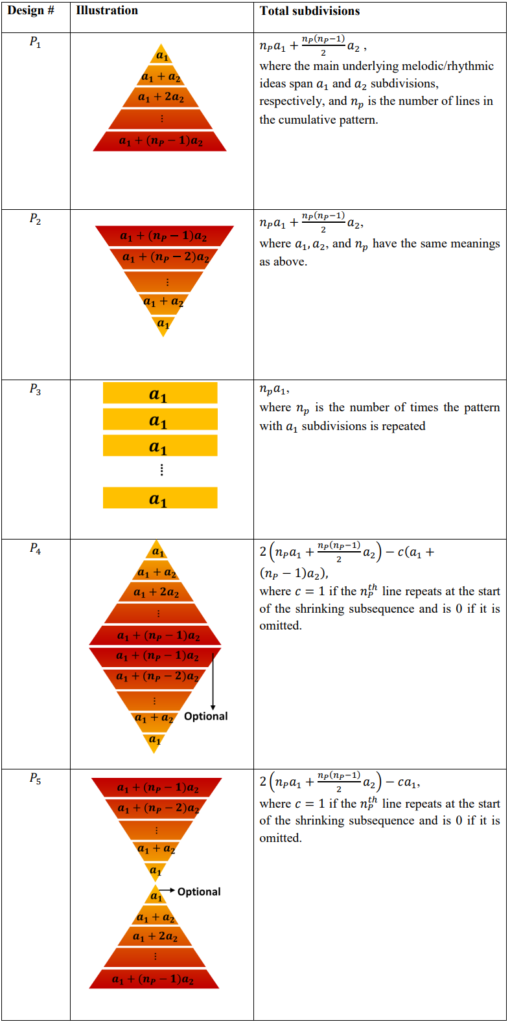
Table A1. Detailed mathematical representations of traditional pūrvārdha structures.
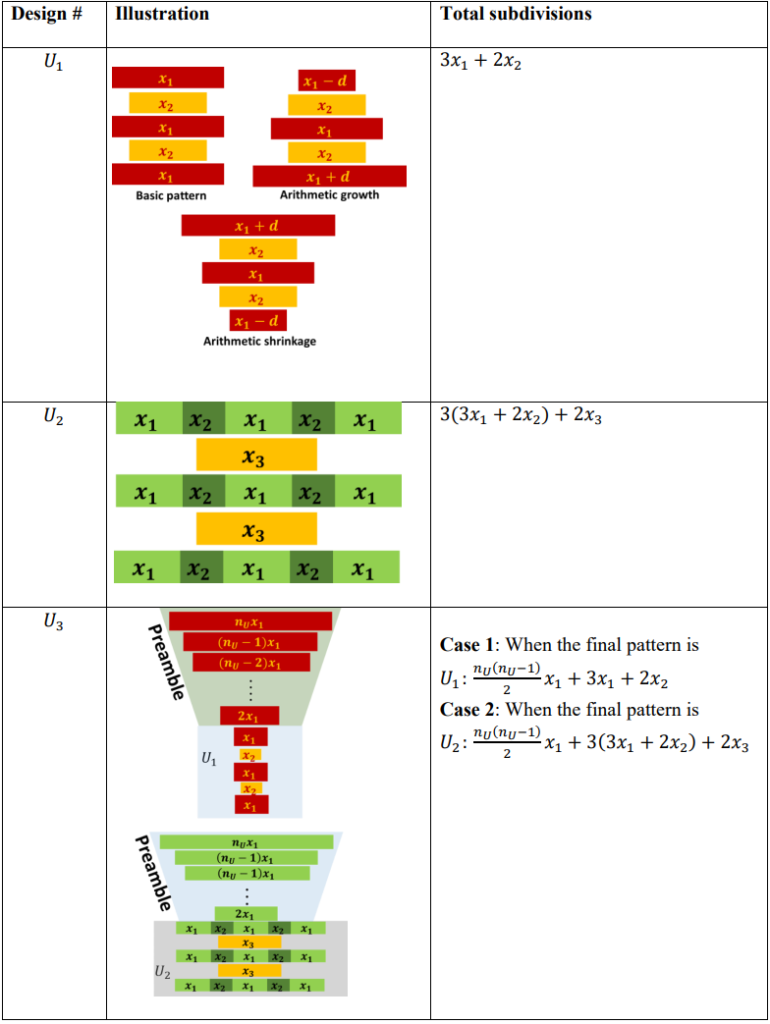
Table A2. Detailed mathematical representations of traditional uttarārdha structures.
Appendix A2: Vocal Kōrvai Transcriptions (See Video Examples 1, 2, 3, 4)
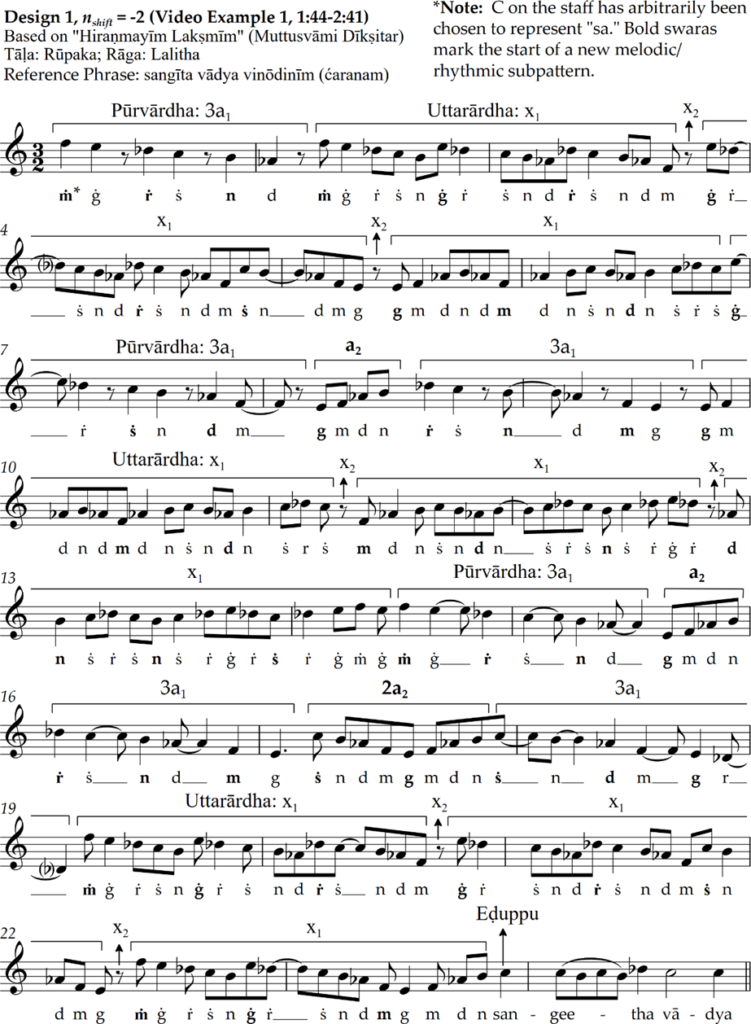



Notes
[1]. Most commonly used tāḷas, such as the suḷādi sapta tāḷas and the cāpu tāḷas, have subdivisions of equal duration. However, there are customized “composite” tāḷas involving multiple naḍais (a concept discussed in paragraphs [16]–[22]) where subdivisions within different beats of a single āvartana are of different durations. Such tālas are not within the purview of our current investigation.
[2]. For a given musical composition, t0 is an artistic choice that depends on the mood of a concert, capabilities of the artist, and the meaning and emotional context of the composition.
[3]. There are conflicting views on the nature of the cāpu tāḷas. For instance, while some artists define miṣra cāpu tāḷa as having seven equal beats, others argue for one long beat (three subdivisions) followed by two shorter beats (two subdivisions). In a conscious departure from Lerdahl and Jackendoff 1983, the authors take the latter view that cāpu tāḷa beats may vary in length; regarding non-isochronous beats, see Polak, London, and Jacoby 2016. More generally, throughout this article, we explicitly assume a culturally relativist, non-universalist perspective in which concepts such as “beat” and “meter” may have definitions, implications, and connotations that vary between musical cultures. Similarly, we acknowledge that ways of listening to, conceiving, and experiencing music may be culture-specific.
[4]. Changing the speed in Carnatic music is roughly analogous to augmentation or diminution in Western music. For instance, if the phrase “Sa—Ri—Ga—Ri—” lasts four beats in first speed, it will last two beats in second speed (“Sa-Ri-Ga-Ri-”) and one beat in third speed (“SaRiGaRi”). See Nelson (2008, 16).
[5]. While many written descriptions of caturaṣra naḍai (especially in Western scholarship) describe it as having four subdivisions per beat (based on the Sanskrit word caturaṣra’s associations with the number four), the lead author’s experience as a student and performer of Carnatic music suggests that this point is debatable. In particular, Carnatic vocalists and percussionists disagree about whether the primary subdivision of caturaṣra naḍai should be one or four. The authors’ perspective, simply stated, is that if the total number of subdivisions per beat is divisible by two, then it is not the most fundamental speed (first speed). An exception to this is the sampūrṇa khanḍa naḍai, where the first speed implies ten subdivisions per beat. While this naḍai can be mathematically treated as khanḍa naḍai in the second speed, the authors prefer not to do so in the current study. In all other cases, the first speed corresponds to an odd integer that fundamentally represents the naḍai.
[6]. There is little clear documentation in the research literature for why kōrvais are traditionally played in threes. From a practical standpoint, playing kōrvais in threes gives co-percussionists about to play in the tani āvartanam, or the main artist preparing for the reference verse after the tani āvartanam, ample time to prepare for subsequent action. A possible technical rationale is that three is the smallest number of mathematical elements required to know what type of mathematical progression is occurring. For example, if the first two elements of a series are one and two, we do not know whether the progression is arithmetic or geometric, as the third element could be three or four, respectively.
[7]. Note that the constraints that follow distill commonly understood principles in Carnatic music. These principles have primarily been passed down orally from teacher to student, meaning there is limited written documentation for them. The lead author presents these principles based on extensive experience as a Carnatic musician and continuing studies with a senior percussionist.
[8]. A multi-naḍai paradigm is an open possibility that will be considered in later work.
[9]. Simply stated, our constraints 1 and 2 are common to all kōrvais, while constraints 3 and 4 may be transgressed in certain contexts.
[10]. While Tables 3 and 4 describe essential Carnatic rhythmic structures, their musical implementation is not complete without optimal melodic phrasing or drum beat patterns that clearly demarcate rhythmic boundaries. In other words, pitch and timbre are imperative to conveying the underlying rhythmic ideas.
[11]. Specifically, if nbns is a multiple of three, then K(nbns) is also a multiple of three. Therefore, if nshift is not a multiple of three, then Ntotal = K(nbns) + nshift cannot be a multiple of three.
[12]. In contrast, consider a scenario where the total number of subdivisions per cycle in a tāḷa is not a multiple of three. An example is ādi tāḷa in the viḷambha kāla (C16,4), which comprises sixteen beats, or sixty-four subdivisions, in the caturaṣra naḍai in third speed (madhyama kāla). Suppose one wants to use conventional structures to compose a kōrvai trio, and nshift = +4—a non-multiple of three, and a reasonably frequent occurrence in concerts. In this case, a trio where each kōrvai is forty-four subdivisions long easily satisfies all constraints, as the total trio length is 44 x 3 = 132, which is equal to two complete tāḷa cycles plus four subdivisions. Thus, if we start on the first subdivision of a cycle, we will end precisely at the eḍuppu. This example shows that satisfying all four constraints, given a single naḍai paradigm, is easy to achieve when the number of subdivisions per tāḷa cycle (nbns) is not equivalent to 0 (mod 3).
[13]. The rūpaka tāḷa has multiple variants. In its shortest form, used here for analysis, it consists of three beats (clap, clap, wave). The second variant is in viḷambha kāla, where each beat of the three-beat shorter version is sounded twice to give a total of 6 beats. These two forms of the tāḷa are important for performance due to their applicability to many compositions. A third variant of rūpaka tāḷa occurs within the suḷādi sapta tāḷa and consists of two angas—a dhṛta (clap + wave) and laghu (clap + finger counts). While the dhṛta consists of two beats, the laghu can consist of either three, four, five, seven, or nine beats depending on its jāti. This variant of the rūpaka tāḷa is not widely applicable in concert settings. The third variant also has viḷambha kāla versions where the number of beats is doubled. For the work presented here, we consider only the first, 3-beat variant of the tāḷa.
[14]. Note that changing the shape of the pūrvārdha will not provide a solution to the central problem, as the pūrvārdha will still need to be repeated three times along with the rest of the kōrvai. Thus, the total number of subdivisions in the composition will still be a multiple of three. Similar arguments can show that the central problem cannot be addressed by trivially choosing a different uttarārdha structure.
[15]. Tāḷas with a large number of beats per cycle can present such a challenge. An extreme example is the simhanandana tāḷa, which is the thirty-seventh of the asṭḥottara ṣata tāḷas and contains 128 beats per cycle. In the caturaṣra naḍai, it contains 512 subdivisions per cycle, which is not a multiple of three. In the trivial situation where playing a kōrvai containing 512 or more subdivisions thrice will be extremely time consuming and, likely, will not be well received by the audience. In such situations, a conventional kōrvai structure using inputs from Tables 3 and 4 over multiple āvartanas would not work. However, adopting our second new kōrvai design with a progressively growing uttarārdha (described later in paragraphs [46]–[48] and [54]) makes it possible to play a complete kōrvai trio within one cycle of the tāḷa. With reference to the descriptions of Design 2, one of the possible solutions is a1 = 24, x1 = 12, x2 = 0, x3 = 10. Hence, the newer approaches to be presented here are also relevant to tāḷas whose total number of subdivisions per cycle is not a multiple of 3.
[16]. The success and popularity of quantitative musical approaches is unsurprising, given that the source of musical creations is human thought, which has strong algorithmic properties (Cope 2015).
[17]. In other words, the pūrvārdha could minimally consist of three phrases of length a1, while the uttarārdha could minimally include three phrases of length x1 (where x2 = 0 in the (x1, x2, x1, x2, x1, structure). See Tables 3–4.
[18]. Other Modern and Contemporary Western art music, of course, draws upon non-equally-tempered and/or tonally influenced pitch and harmonic syntaxes, and may explore new timbral possibilities.
[19]. Composer Igor Stravinsky argued in favor of external compositional constraints more broadly, writing that “the more constraints one imposes, the more one frees one’s self of the chains that shackle the spirit” (Stravinsky [1947] 2003, 65). Straus (2004) suggests that “devising appropriate constraints was, for Stravinsky, an integral part of the compositional or, more properly, precompositional process” (44).
[20]. In Carnatic music, rhythmic patterns lasting n subdivisions typically occur in a limited number of ways, each corresponding to a particular konnakkol pattern (Vedavalli 1995; Krishnamurthy 2021). For instance, a 7-subdivision group frequently occurs as the even pattern “tha ka dhi mi tha ki ṭa” or the uneven pattern “tha – dhi – gi na thom”. Moreover, Carnatic rāgas include not only specific pitches, but characteristic ornaments (gamakas), phrases (prayōgas), and extramusical associations. The more of these rhythmic and melodic parameters a composer implements, the closer a kōrvai will be to Carnatic usages.
[21]. The sixth and seventh notes of the scale, F and G, sometimes occur in their natural form and are sometimes raised to F# and G#, respectively. As such, the melody has a strong melodic minor flavor.
